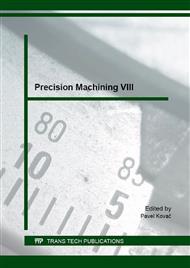[1]
Sandvik Coromant. Contouring or copy milling. http: /www. sandvik. coromant. com/en-gb/knowledge/milling/application_overview/profile_milling/contouring_or_copy_milling/pages/default. aspx.
Google Scholar
[2]
P. Pokorný, J. Peterka, Š. Václav, The task of 5-axis milling. Tehnicki Vjesnik - Technical Gazette. Vol. 19, No. 1, pp.147-150, 2012. ISSN 1330-3651.
Google Scholar
[3]
M. Fontaine, A. Devillez, A. Moufki, D. Dudzinski. Modeling of cutting forces in ball end milling with tool surface inclination. Part II. Influence of cutting conditions, run-out, ploughing and inclination angle. J. Mater. Process. Technol., 189 (1–3) p.85–89, (2007).
DOI: 10.1016/j.jmatprotec.2007.01.007
Google Scholar
[4]
A. Daymi, M. Boujelbene, J.M. Linares, E. Bayraktar, A. Ben Amara. Influence of workpiece inclination angle on the surface roughness in ball end milling of the titanium alloy Ti–6Al–4V. J. Achiev. Mater. Manuf. Eng., 35 (1), p.79–86, (2009).
DOI: 10.1179/026708310x12738371692932
Google Scholar
[5]
Antoniadis, A., Bilalis, N., Savakis, C., Maravelakis, E., Petropoulos, G., Influence of machining inclination angle on surface quality in ball end milling. In: Proceedings of AMPT. Dublin, Ireland. (2003).
Google Scholar
[6]
H. Schulz, S. Hock, High-speed milling of die and moulds – cutting conditions and technology. Annals of the CIRP 44, pp.35-38, (1995).
DOI: 10.1016/s0007-8506(07)62270-7
Google Scholar
[7]
A.G. Mamalis, A.I. Grabchenco, V.A. Fedorovich, J. Kundrak. Methodology of 3D simulation of processes in technology of diamond-composite material. Int. J. Adv. Manuf. Technol., 43 (11–12), p.1235–1250, (2009).
DOI: 10.1007/s00170-008-1802-0
Google Scholar
[8]
H.K. Tonshoff, J. Hernandez-Camacho, Die manufacturing by 5 and 3 axes milling, Journal of Mechanical Working Technology 20 (1989) pp.105-119.
DOI: 10.1016/0378-3804(89)90022-3
Google Scholar
[9]
C.C. Tai, K.H. Fhu, A predictive force model in ball-end milling including eccentricity effects, Int. J. Mach. Tools Manufact. 34 (1994) p.959–979.
DOI: 10.1016/0890-6955(94)90028-0
Google Scholar
[10]
J. Peterka, Analysis of the geometry and kinematics of copy milling, in Vedecké práce (Science Theses) MTF STU in Trnava, 5, 1997, pp.53-58.
Google Scholar
[11]
International Organization for Standardization. Tool-life testing with single-point turning tools, 1993. ISO 3685.
Google Scholar


